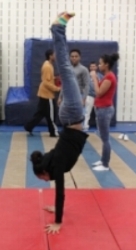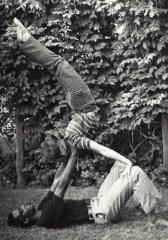"Sharing Creations" Explore - Invent - Share
When two, three, four or more people want to create a variety of balancing and movement forms, they learn to collaborate, try a variety of options and decide on sequences - sometimes with music.
"Sharing Creations": Explore - Invent - Share
When two, three, four or more people want to create a variety of balancing and movement forms, they learn to collaborate, try a variety of options and decide on sequences - sometimes with music.
Individual students can develop interesting Sequences and Performances by taking the time to try new things as they work with a variety of others. The Student is the Teacher. Based on interests the student brings to learning time, their interests and are shared with those who seek to support their development. Those providing support assist as they come to know the unique ways of each student.
There are many things to be learned in order to master a complex event or field of academic study - whether the subject is: Balancing in a “Gymcraftics” practice time, Pole Vaulting, Vector Analysis, Hurdling, or Social Studies.
"Gymcraftics is a name given to that which has been happening in gyms as individuals figure out ways to balance alone and with each other.
Individuals who learn basic skills well and reach goals that stretch their potentials have much in common.
1- They have chosen to develop skills consistently over time.
2- They are initiators - advocates for regularly scheduled practices; interested in feedback about that which is being learned; and, seeking opportunities to test their skills in a variety of ways: demonstrating to friends and family and performances.
3- They expect to work hard and figure out each element in the complex structure of their process.
4- They understand that a “Mastery Approach” is necessary for high achievement. First learn A, then B, before expecting to be able to do C well, the third step in a sequence.
5- They are carefully and actively supported at home and cope well with obstacles that develop.
6- They are focused when practicing, and thrive on intensive small group and 1:1 sessions.
7- They form a relationship with peers and the coach in which both student and coach work constantly to define, implement and improve the developing process.
8- They are mentors for others, but, not at the expense of their own development.
9- They sacrifice when necessary in order to do the work needed to reach stated goals.
10- They enjoy discovering, performing, and achieving. And, during all of this - remain connected to their family, friends and other interests.
* * * * * * *
Individual
There is - or - “is there” in each learning time - an opportunity for those seeking to understand, those wanting to try, and, those asking for support to be heard?
Is the learner in today’s world better off if told what to learn, to study, to read – or – perhaps they can be asked – “What would you like to know; to discover; to find out about; “to learn”?
When a door swings open and the learner asks for support, is someone listening?
When a person, whether 6 or 64 observes someone who is trying something complex, is there an opportunity to try that which is being observed?
What is Support? What is Encouragement? Who is Listening? How is a person to Explore? Alone? Who has a Voice? Who asks Questions? Who Initiates?
When we think to ourselves – “What is achievement?” How is it determined? Is each person supposed to measure up to a “fixed level or standard”? Who asks of each student – “what may be your most positive and productive way of learning?”
Maybe each person can be seen as a “unique combination” which has begun and grown – over time.
What have been and will be the present and next steps?
Who will determine how they develop?
What support “one-on-one” will exist for each person?
And, will the “learner” have ongoing supportive persons and processes that make sense to her or him?
The learner in the educational setting is the teacher. In the sports environment the learner is the coach. Each student has interests and potentials. The means for finding the interests can belong to each teacher and coach. All people need feedback and support from an “observer”, friend, colleague or parent.
The student in effect is the teacher.
Those of us who are learning about each student are the learners.
* * * * * * *
Pairs
For the athlete in each of us it can offer:
- A way to get in touch with hidden potentials
- A means for understanding movement with support
- A process for creating patterns to improve performance
- A way to recover from practice, a race, event or game
As one parent/participant described it-
“As muscles and abilities develop, human beings learn to unfreeze and to react to things around them: light, music, throbbing rhythms and other human beings.
People learn to acknowledge one another in their individual movements and in their interdependence to reach a result…
To an observer, the variety in the group’s human shapes, sizes and complexions is as interesting as the variety in their minds, viewpoints and temperaments as they work through the meaning and significance of this experience.”
Gymcraftics is a set of activities, attitudes, processes and explorations that are as useful to the beginner as the experienced. Each person who does ‘gymcraftics’ finds that its usefulness, meaning and definition are understood when:
- balancing with another person
- physically and emotionally supporting others
- working to create a physical design
- filming and providing visual feedback
- creating a sequence of physical positions that connect and flow from one to the next
- finding support in order to try, refine and perfect a movement or sequence
- discovering how to work with other people in verbal and non-verbal tasks
- relating balance and support to other situations in athletics, academics, the arts and life.
* * * * * * *
Triples
· Students use the concepts explored in pairs balancing to form groups of three and complete similar tasks.
· They learn how to move from one balance to the next, working towards creating a fluid sequence.
· During regular Sharing Circles groups may present their work and hear feedback from observers.
· Small Group Work, such as triples, allows for input from a variety of participants. Learning to work with others and to have a voice can be more difficult as the size of the group grows. It may be worthwhile to have two sets of pairs join to make up the working of a group of 4. The facilitator may structure a session as follows: 'The four of you will spend the next fifteen minutes crating 3 balancing positions. At all times you must be connected physically. Pace yourselves according to the tempo of the music I play. Let your interpretation of the music dictate the kinds of movements you make. You may talk at all times when planning, building and moving.'
* * * * * * *
Quads
* * * * * * *
Small Group
Small groups can build structures or forms. Usually this group is kept at 12 or less in order for their to be adequate sharing and time to successfully construct. Sometimes a facilitator helps establishes space, time and design parameters. For example: "You have ten minutes to construct a 'bridge-like' structure which will reach from that corner of the mats to this one {locations clearly identified}. Only half of you will be touching the ground when the structure is completed. You may not talk during your work, and, you will add one person at a time with the second person added once the first has stopped moving, etc - until all are included. Then, you will hold the structure until a still photograph is taken.
. Whether ten two-person pairs routines; five four person quads routines; one twenty person domino line; or one twenty person structure - a circle is formed. The "facilitator" {coach, teacher, student or parent} tells the group the process for sharing. Example: "We will go around the circle one time in 'this direction'. Each of us will have the opportunity to say what we found 'interesting'. While each person is talking, all of us are listening. When it is your turn - you may speak or pass.
"Okay - lets begin." When the circle is complete - the facilitator then indicates what is next.
* * * * * * *
Large Group
8






















































